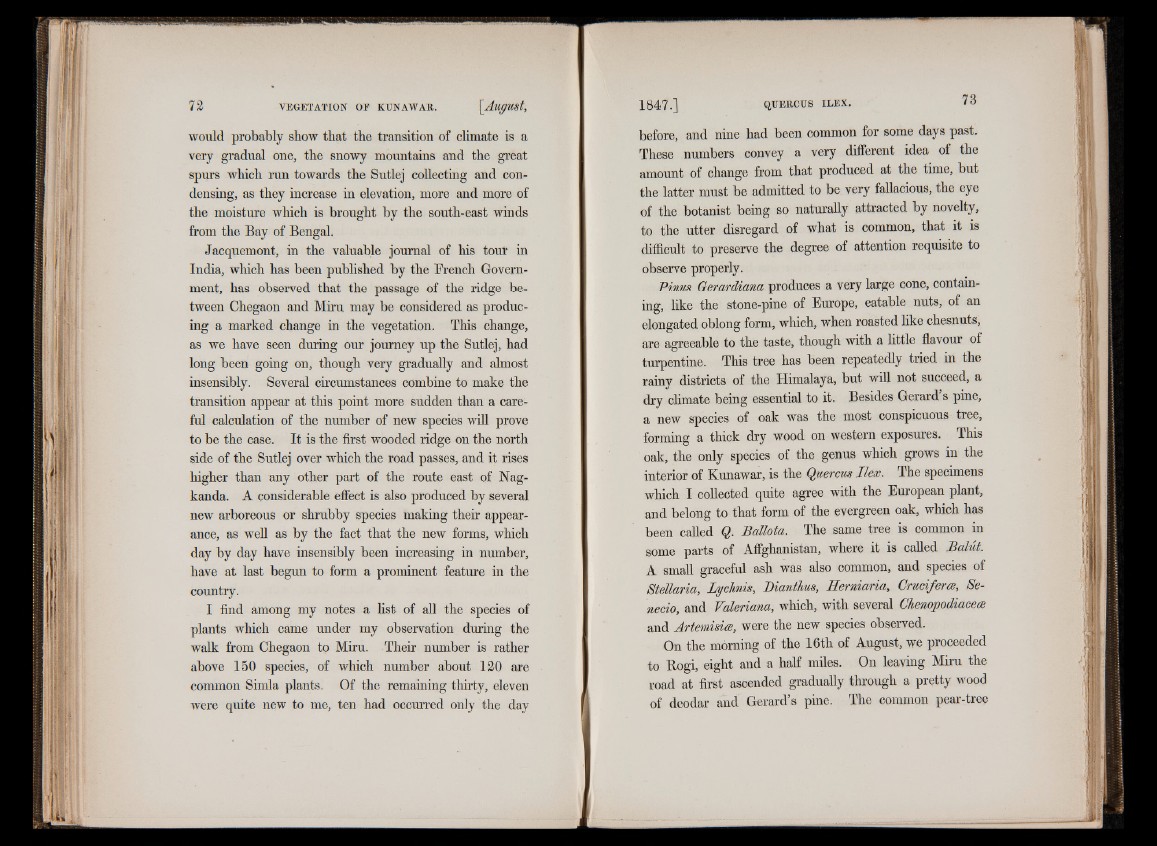
would probably show that the transition of climate is a
very gradual one, the snowy mountains and the great
spurs which run towards the Sutlej collecting and condensing,
as they increase in elevation, more and more of
the moisture which is brought by the south-east winds
from the Bay of Bengal.
Jacquemont, in the valuable journal of his tour in
India, which has been published by the French Government,
has observed that the passage of the ridge between
Chegaon and Miru may be considered as producing
a marked change in the vegetation. This change,
as we have seen during our journey up the Sutlej, had
long been going on, though very gradually and almost
insensibly. Several circumstances combine to make the
transition appear at this point more sudden than a careful
calculation of the number of new species will prove
to be the case. It is the first wooded ridge on the north
side of the Sutlej over which the road passes, and it rises
higher than any other part of the route east of Nag-
kanda. A considerable effect is also produced by several
new arboreous or shrubby species making their appearance,
as well as by the fact that the new forms, which
day by day have insensibly been increasing in number,
have at last begun to form a prominent feature in the
country.
I find among my notes a list of all the species of
plants which came under my observation during the
walk from Chegaon to Miru. Their number is rather
above 150 species, of which number about 120 are
common Simla plants. Of the remaining thirty, eleven
were quite new to me, ten had occurred only the day
before, and nine had been common for some days past.
These numbers convey a very different idea of the
amount of change from that produced at the time, but
the latter must be admitted to be very fallacious, the eye
of the botanist being so naturally attracted by novelty,
to the utter disregard of what is common, that it is
difficult to preserve the degree of attention requisite to
observe properly.
Pinus Gerardiana produces a very large cone, containing,
like the stone-pine of Europe, eatable nuts, of an
elongated oblong form, which, when roasted like chesnuts,
are agreeable to the taste, though with a little flavour of
turpentine. This tree has been repeatedly tried in the
rainy districts of the Himalaya, but will not succeed, a
dry climate being essential to it. Besides Gerard s pine,
a new species of oak was the most conspicuous tree,
forming a thick dry wood on western exposures. This
oak, the only species of the genus which grows in the
interior of Kunawar, is the Quercus Ilex. The specimens
which I collected quite agree with the European plant,
and belong to that form of the evergreen oak, which has
been called Q. Ballota, The same tree is common in
some parts of Affghanistan, where it is called Balút.
A small graceful ash was also common, and species of
Stellaria, lychnis, Dianthus, Hemiaria, Crucifera!, Senecio,
and Valeriana, which, with several Chenopodiacea
and Artemisia, were the new species observed.
On the morning of the 16th of August, we proceeded
to Rogi, eight and a half miles. On leaving Miru the
road at first ascended gradually through a pretty wood
of deodar and Gerard’s pine. The common pear-tree